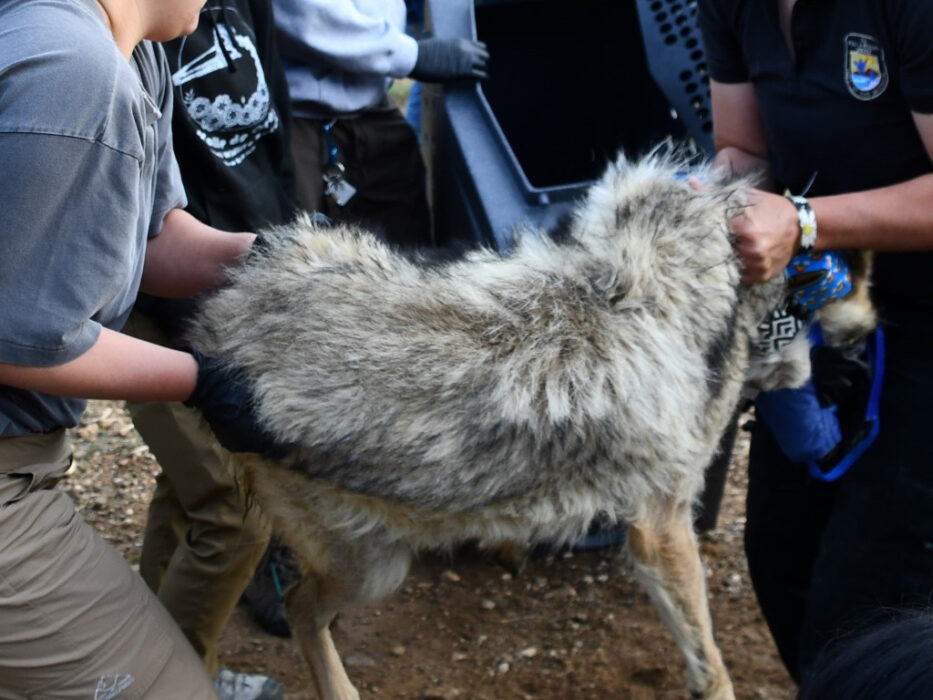Current work in wildlife, rivers, public lands, and climate
Press Releases
Asha denied freedom for failure to breed
Since December 2023, the last time Asha was taken from near the Valles Caldera National Preserve in the Jemez Mountains of New Mexico, she has been held in a facility near Socorro. Prior to this announcement, the U.S. Fish and Wildlife Service had approved Asha’s release “on the condition of successful breeding and producing pups.”
“Asha deserves to be free and wild. She has done nothing wrong–she has followed her instincts into suitable wolf habitat in northern New Mexico and is being punished for it,” said Chris Smith, wildlife program director for WildEarth Guardians. “Asha belongs in the wild whether she breeds or not; there are some pretty telling layers to this.”
“We need to let lobos lead, respect their sentience, and learn from Asha and her family,” said Claire Musser, executive director of the Grand Canyon Wolf Recovery Project. “The Caldera pack should be free to live their own lives and make their own choices. We should embrace the opportunity to make new scientific discoveries by allowing wolves to teach us, rather than continuing to disrupt and control their lives.”
The Fish and Wildlife Service’s decision to keep Asha in captivity, rather than release her along with her male partner, Arcadia, is consistent with the state wildlife agency’s long-held opposition to releasing almost any captive-born wolves except for young pups removed from their parents, who have been released since 2016 but with a high disappearance rate.
“This wolf, and others like her, are showing us where the wolves want to be. The human-created maps, with imaginary lines on the ground where wolves are not allowed, ignores what science tells us – that the southern Rocky Mountains are home to the Mexican gray wolf,” said Cyndi Tuell, Western Watersheds Project’s Arizona and New Mexico director. “Making Asha’s freedom dependent on her ability to breed represents an outdated and unscientific philosophy held by wildlife managers that needs to change.”
“Asha’s value to her species isn’t solely as a breeder – she’s an experienced wild wolf with important knowledge and traditions to share with other wolves. Depriving her of the wild is also depriving wild lobos of her keen instincts, and is yet another setback on the path to true recovery,” said Regan Downey, director of education of the Wolf Conservation Center.
“The wild lands of northern New Mexico are incomplete without lobos,” said Sally Paez, staff attorney for New Mexico Wild. “It’s time for wildlife managers to use their authority to support the natural dispersal of Mexican wolves into suitable landscapes such as Valles Caldera and the Jemez Mountains to restore balance to our treasured public lands and ecosystems.”
“It’s achingly clear that Asha and her mate could contribute to wolf recovery if only the government would allow it,” said Michael Robinson, a senior conservation advocate at the Center for Biological Diversity. “Keeping them behind wire mesh for another year shows how politics are prioritized over wolf releases, as well as the livestock industry’s success at blocking wolves north of Interstate 40. Both have contributed to alarming declines in the genetic diversity of Mexican wolves since the early days of reintroduction.”
Asha is one of several wolves who have made headlines recently by repeatedly dispersing north of Interstate 40. Anubis, a male lobo, made two journeys to the Flagstaff area in Arizona before being killed in January 2022. One of two wolves currently north of Interstate 40 in Arizona has been captured and collared in an attempt to capture the second wolf so they can be relocated.
Conservation groups say the arbitrary Interstate 40 boundary beyond which wolves cannot go is the result of state pressure to restrict the recovery of Mexican wolves to a limited portion of the Southwest. But leading scientists have suggested that three interconnected subpopulations of at least 200 wolves each need to be present in the Southwest to achieve recovery. The southern Rocky Mountains and the Grand Canyon Ecoregion represent excellent opportunities for two new subpopulations, along with the existing population of roughly 260 lobos in the Greater Gila Bioregion.
“Her value does not depend on whether she can breed,” said Smith. “She is a wild wolf who has proven she can take care of herself in the wild, and should be allowed to do so.”

Photo: U.S. Fish and Wildlife Service
###